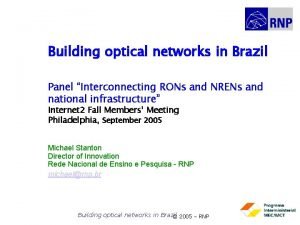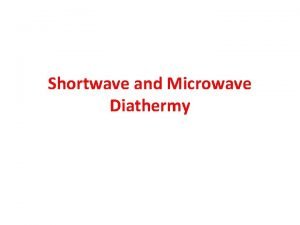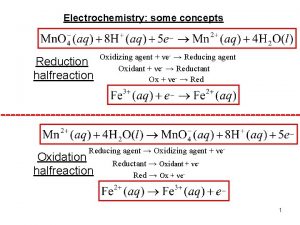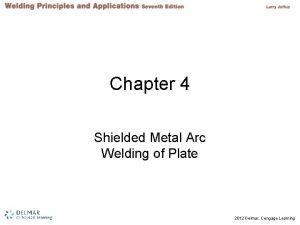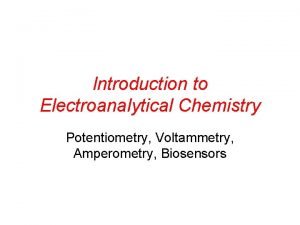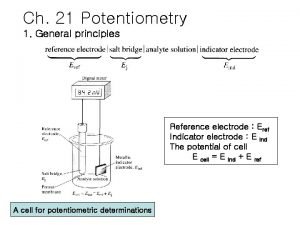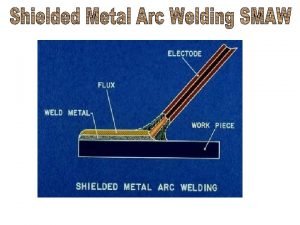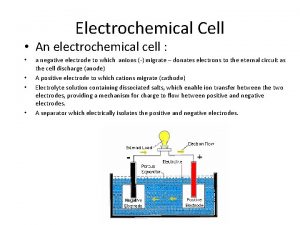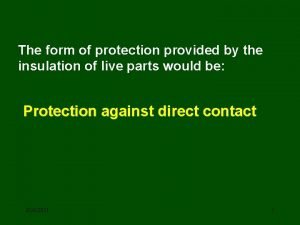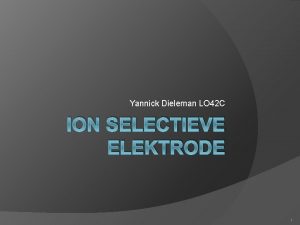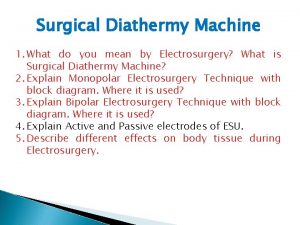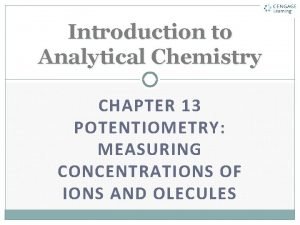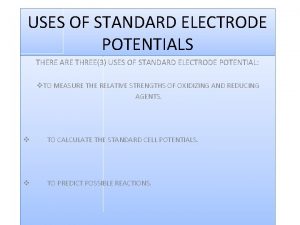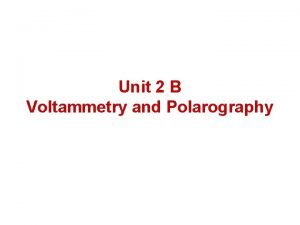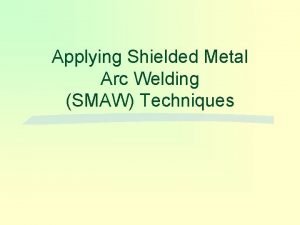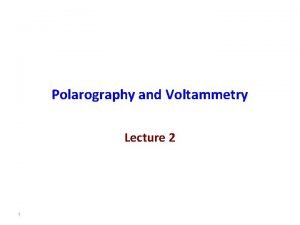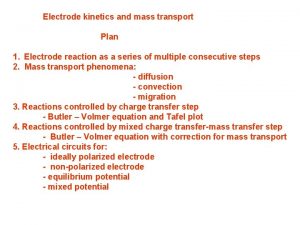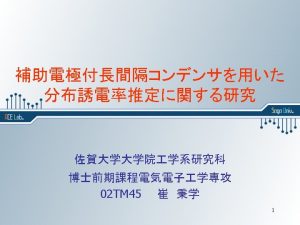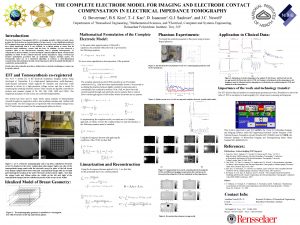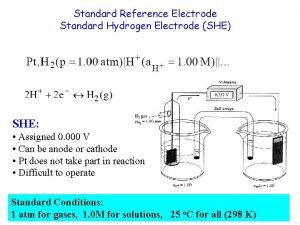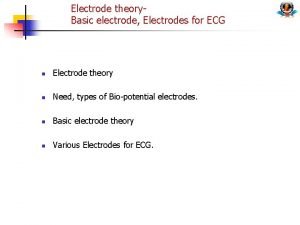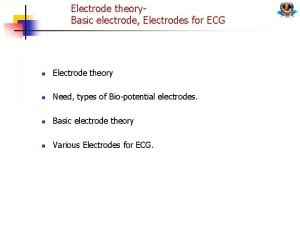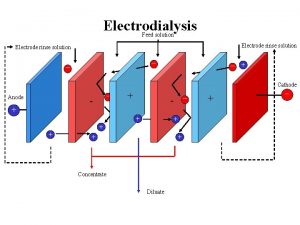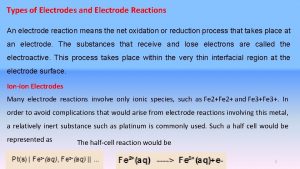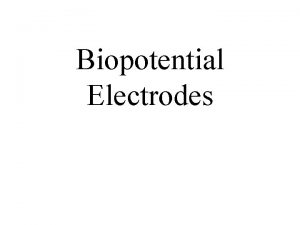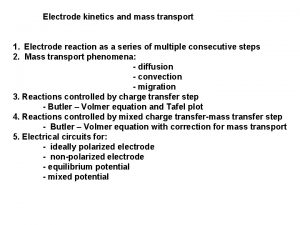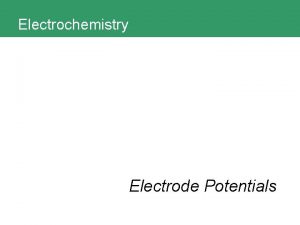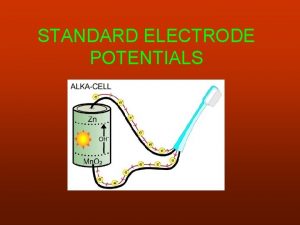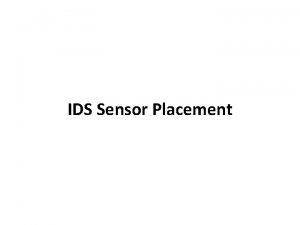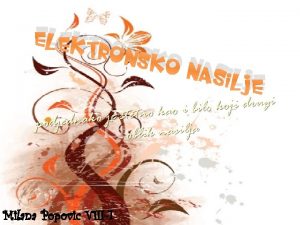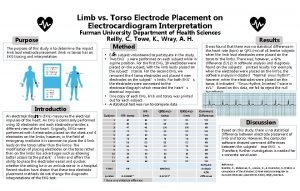IMPACT OF ELECTRODE PLACEMENT ON RONS PRODUCTION IN





















- Slides: 21

IMPACT OF ELECTRODE PLACEMENT ON RONS PRODUCTION IN ATMOSPHERIC PRESSURE PLASMA JETS* Amanda M. Lietza and Mark J. Kushnerb a)Dept. Nuclear Engineering and Radiological Sciences Electrical Engineering and Computer Science University of Michigan, Ann Arbor, MI 48109, USA lietz@umich. edu, mjkush@umich. edu, http: //uigelz. eecs. umich. edu b)Dept. 7 th Annual MIPSE Graduate Student Symposium Ann Arbor, MI 5 October 2016 * Work was supported by the DOE Office of Fusion Energy Science and the National Science Foundation.

AGENDA · Atmospheric Pressure Plasma Jets · Model Description: non. PDPSIM · Base Case – Single Powered Ring Electrode · Ionization Wave · Reactive Neutrals · · · Powered Electrode Placement Along Tube 1 Outer Electrode vs 2 Outer Electrode Inner HV Electrode vs. Outer HV Electrode Distant Radial Ground Planes Concluding Remarks MIPSE_2016 University of Michigan Institute for Plasma Science & Engr.

ATMOSPHERIC PRESSURE PLASMA JETS · Atmospheric pressure plasma jets (APPJs) in plasma medicine have been studied for: · Sanitizing wounds without tissue damage · Reducing size of cancerous tumors · Eradicating bacteria in biofilms · Rare gas with small amounts of O 2 to increase reactive oxygen and nitrogen species (RONS) production. · Control of RONS production is key to influencing biological systems. MIPSE_2016 Joh, H. et al. Applied Phys. Letters, 5, 101 (2012) O’Connor, N. J. Applied Phys. , 110, 013308 (2011) University of Michigan Institute for Plasma Science & Engr.

CONTROL OF RONS PRODUCTION · Many designs of APPJs differ in the arrangement of electrodes on the tube. · Comparison of these designs would allow for better selection of an APPJ design for a given application. · Side-by-side comparison of APPJs is challenging due to poorly known effects of secondary parameters. J Winter et al PSST 24, 064001 (2015) · Objective: Computationally investigate the effect of electrode configuration on breakdown dynamics and RONS production in an APPJ with powered outer ring electrode. MIPSE_2016 University of Michigan Institute for Plasma Science & Engr.

Plasma Hydrodynamics Poisson’s Equation Bulk Electron Energy Transport Neutral Transport Navier-Stokes Gas Phase Plasma Kinetic “Beam” Electron Transport Neutral and Plasma Chemistry Radiation Transport Surface Chemistry and Charging Ion Monte Carlo Simulation Circuit Model MIPSE_2016 MODEL: non. PDPSIM · Unstructured mesh. · Fully implicit plasma transport and gas dynamic transport. · Electron temperature equation for bulk electrons with Boltzmann derived transport coefficients. · Radiation transport and photoionization. · Time slicing algorithms between plasma and fluid timescales. University of Michigan Institute for Plasma Science & Engr.

GAS FLOW and MESH · · · · Cylindrically symmetric 170 ns pulse, -8 k. V pulse 20 ns rise time, 20 ns fall He/O 2/N 2/H 2 O (2. 4/4. 7/2. 9 ppm), 1 atm, 2 slm into humid air Tube ɛr = 4, 250 µm thick Steady-state flow established before plasma Reaction mechanism: He/N 2/O 2/H 2 O, 51 species, 717 reactions 12, 572 nodes, spacing 50 µm in tube MIN MIPSE_2016 Linear scale MAX University of Michigan Institute for Plasma Science & Engr.

BASE CASE: IONIZATION WAVE · -8 k. V, 200 ns · Se – electron impact ionization source · Plasma propagates as ionization wave (IW) from powered electrode. · As IW propagates along the tube, inner wall is negatively charged while the area by the electrode is positive. · Additional ionization source when voltage turns off. · Cathode-directed streamer forms later due to photoionization. MIN MIPSE_2016 Log scale MAX University of Michigan Institute for Plasma Science & Engr.

BASE CASE: ROS FORMATION · 41 s · O 2*, O, OH and H 2 O 2 form inside the tube · O 3 and HO 2 produced where plasma contacts air · Initial ROS production e + O 2* + e e + O 2 O - + O e + O 2 O + e e + O 2 + O + O H 2 O+ + H 2 O H 3 O+ + OH · At longer timescales O + O 2 + M O 3 + M H + O 2 + M HO 2 + M OH + M H 2 O 2 + M MIN MIPSE_2016 Log scale MAX University of Michigan Institute for Plasma Science & Engr.

BASE CASE: RNS FORMATION · 100 s · N and NO are produced in the tube. · NO 2 and HNOx are formed outside of the tube. · N atom produced initially e + N 2 N + e e + N 2+ N + N N 2* + O NO + N · Much of the N produced recombines N + M N 2 + M · Reactions with ROS produce other RNS NO + M NO 2 + M NO + OH + M HNO 2 + M NO 2 + OH + M HNO 3 + M NO 2 + OH + M ONOOH + M MIN MIPSE_2016 Log scale MAX University of Michigan Institute for Plasma Science & Engr.

ELECTRODE DISTANCE FROM OUTLET · -8 k. V, 200 ns · ne at 152 ns; Se at 36 ns · For a single ring electrode jet, placing the electrode closer to the tube outlet leads to a more intense IW. · IW exits the tube sooner, greater energy deposition outside of tube. · This effect is most important for short pulses. · IW propagation time ~ pulse duration MIN MIPSE_2016 MAX Log scale University of Michigan Institute for Plasma Science & Engr.

ELECTRODE DISTANCE FROM OUTLET - RONS · Inventory – volume integrated number of molecules at 220 s · Moving electrode closer to outlet increases all RONS. · Species originating from H 2 O (OH, H 2 O 2, H 2) are the least sensitive to distance to exit, as a significant amount of these species are made inside the tube, even for 3 mm. · For the other species at 3 mm, formation outside the tube dominates for all other RONS. · Only 10 ppm O 2/H 2 O/N 2 in He – results would be different with an admixture. University of Michigan MIPSE_2016 Institute for Plasma Science & Engr.

1 RING vs 2 RING ELECTRODE IW · ne at 174 ns; Se at 36 ns · A grounded ring produces a faster IW, and a generally more intense plasma. · IW wave is initially faster (larger Ez), it slows when it passes the grounded ring to charge the higher capacitance. · Plasma is significantly more annular with grounded ring. Animation Slide MIN MIPSE_2016 MAX Log scale University of Michigan Institute for Plasma Science & Engr.

1 RING vs 2 RING ELECTRODE: RONS · Inventory – volume integrated number of molecules at 220 s · All RONS increase when a grounded ring is added except HO 2. · Though more HO 2 is produced with 2 rings, it reacts with the elevated levels of NO, forming HNO 3 and ONOOH by 220 s. · RONS originating from H 2 O are again the less sensitive. Because H 2 O has the lowest ionization potential and the pathway H 2 O+ + H 2 O H 3 O+ + OH H 2 O + + M - H 2 O + H + M produces OH and H. MIPSE_2016 University of Michigan Institute for Plasma Science & Engr.

DISTANT GROUND PLANES - ne · The presence of ground planes which are not on the tube are often not controlled. · A ground in close proximity increases Er in the tube. · ne profile is more annular with nearby grounds due to greater Er. · Capacitance to ground increases, more charging of inner wall. MIN MIPSE_2016 MAX Log scale University of Michigan Institute for Plasma Science & Engr.

DISTANT GROUND PLANES - Se · Faster IW with a nearby ground means the plasma reaches the ambient faster. · For a finite pulse duration, this allows more power deposition outside of the tube. · Here the ground is assumed to be cylindrically symmetric, this would rarely be the case for an uncontrolled ground. · This may lead to nonuniformity. MIN MIPSE_2016 MAX Log scale University of Michigan Institute for Plasma Science & Engr.

DISTANT GROUND PLANES - RONS · Most RONS decrease with increasing radial ground distance · Nearby grounds (stray capacitance of the APPJ) can increase the IW intensity. · The higher RNS (HNOx and ONOOH) are particularly sensitive – 3 orders of magnitude drop from r = 0. 4 to 5. 4 cm. MIPSE_2016 University of Michigan Institute for Plasma Science & Engr.

CONCLUDING REMARKS · Electrode configuration of an APPJ can be used to control the regions of power deposition, and the resulting RONS production. · Confining power deposition inside the tube is a trade-off: · provides more control over RONS production (RONS reflect feedgas composition). · produces less RONS. · Power deposition can be confined to the tube by: · Moving the powered electrode further from the tube outlet. · Using short pulse durations. · Placing a ground electrode on the tube. · Removing any nearby grounds. · For pure He, the species originating from H 2 O are less sensitive to these parameters. MIPSE_2016 University of Michigan Institute for Plasma Science & Engr.

SUPPLEMENTAL SLIDES ICPM_2016 University of Michigan Institute for Plasma Science & Engr.

BASE CASE: IONIZATION WAVE · -8 k. V, 200 ns · Plasma propagates as ionization wave (IW) from powered electrode. · As IW propagates along the tube, inner wall is negatively charged while the area by the electrode is positive. · Additional ionization source when voltage turns off. · Cathode-directed streamer forms later due to photoionization. · Simplified photoionization model includes excimer only · Photoionization hotspot at the end of tube due to high gradient of O 2/N 2/H 2 O density MIN MIPSE_2016 Log scale MAX Animation Slide University of Michigan Institute for Plasma Science & Engr.

BASE CASE: ROS FORMATION · O 2*, O, OH and H 2 O 2 form inside the tube · O 3 and HO 2 produced where plasma contacts air · Initial ROS production e + O 2* + e e + O 2 O - + O e + O 2 O + e e + O 2 + O + O H 2 O+ + H 2 O H 3 O+ + OH · At longer timescales O + O 2 + M O 3 + M H + O 2 + M HO 2 + M OH + M H 2 O 2 + M Animation Slide MIN MIPSE_2016 Log scale MAX University of Michigan Institute for Plasma Science & Engr.

BASE CASE: IONIZATION WAVE · -8 k. V, 200 ns · Plasma propagates as ionization wave (IW) from powered electrode. · As IW propagates along the tube, inner wall is negatively charged while the area by the electrode is positive. · Additional ionization source when voltage turns off. · Cathode-directed streamer forms later due to photoionization. · Simplified photoionization model includes excimer only · Photoionization hotspot at the end of tube due to high gradient of O 2/N 2/H 2 O density MIPSE_2016 University of Michigan Institute for Plasma Science & Engr.
 Rons optical
Rons optical Proses produksi multimedia
Proses produksi multimedia Logging disadvantages
Logging disadvantages Spoon shaped electrode
Spoon shaped electrode Drum electrode
Drum electrode Antioxidant graphite electrode
Antioxidant graphite electrode Standard potential table
Standard potential table Chapter 4 shielded metal arc welding
Chapter 4 shielded metal arc welding Finomation
Finomation Bernard short stub electrode holder
Bernard short stub electrode holder Principle of potentiometry
Principle of potentiometry Welding smaw
Welding smaw Cathode is the negative electrode
Cathode is the negative electrode Earth electrode
Earth electrode Ion selectieve elektrode
Ion selectieve elektrode Electrodes used in surgical diathermy
Electrodes used in surgical diathermy Calomel electrode cell reaction
Calomel electrode cell reaction Uses of standard electrode potential
Uses of standard electrode potential Polarography application
Polarography application Correct amp setting depends on the
Correct amp setting depends on the Dropping mercury electrode diagram
Dropping mercury electrode diagram Monophasic vs biphasic defibrillator joules
Monophasic vs biphasic defibrillator joules
